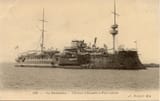Search Results
7/3/2025, 9:32:31 PM
>>96007870
The years following the reconnection with Paris saw most of the focus and attention of the newly founded République inward and downward, the enormous material and economic cost of the Eiffel Tower delaying any form of revival of the navy. By the time the parisian economic bloom would allow it in 72, many of the innovations that would earlier set France's ships ahead of its competitors, such as Paixhan guns, screw propellers, superior armour plating and enclosed gun mounts, were already being featured on British, German and American ships. Between the Accord du Ponant, Britain's heavyhanded limitations on French military ships allowed down the Mt. Snaefellsjokull Entrance, a more cluttered geopolitical board than two decades earlier and the specific needs of ships travelling on Neo-Thetys, the design philosophy of the Jeune École saw some modifications. The reinvented Petite École similarly emphasized the need for smaller ships, but did not plan so much for their use en masse against enemy Epigean Colonial merchant navies as it did for fast redeployment between the Mediteranean, south-east Asian and Agarthan theaters. Torpedoe boats, famously lacking in endurance and seakeeping activities, did not seem as attractive as they once did, and either cruisers or the smaller ironclad rams of the Bélier class came to replace them. Larger ironclads would still see production, with the Redoutable being launched from Lorient in 76 and being adopted as the basis for the Dévastation class, expanded to a total of 5 ships.
The years following the reconnection with Paris saw most of the focus and attention of the newly founded République inward and downward, the enormous material and economic cost of the Eiffel Tower delaying any form of revival of the navy. By the time the parisian economic bloom would allow it in 72, many of the innovations that would earlier set France's ships ahead of its competitors, such as Paixhan guns, screw propellers, superior armour plating and enclosed gun mounts, were already being featured on British, German and American ships. Between the Accord du Ponant, Britain's heavyhanded limitations on French military ships allowed down the Mt. Snaefellsjokull Entrance, a more cluttered geopolitical board than two decades earlier and the specific needs of ships travelling on Neo-Thetys, the design philosophy of the Jeune École saw some modifications. The reinvented Petite École similarly emphasized the need for smaller ships, but did not plan so much for their use en masse against enemy Epigean Colonial merchant navies as it did for fast redeployment between the Mediteranean, south-east Asian and Agarthan theaters. Torpedoe boats, famously lacking in endurance and seakeeping activities, did not seem as attractive as they once did, and either cruisers or the smaller ironclad rams of the Bélier class came to replace them. Larger ironclads would still see production, with the Redoutable being launched from Lorient in 76 and being adopted as the basis for the Dévastation class, expanded to a total of 5 ships.
Page 1
